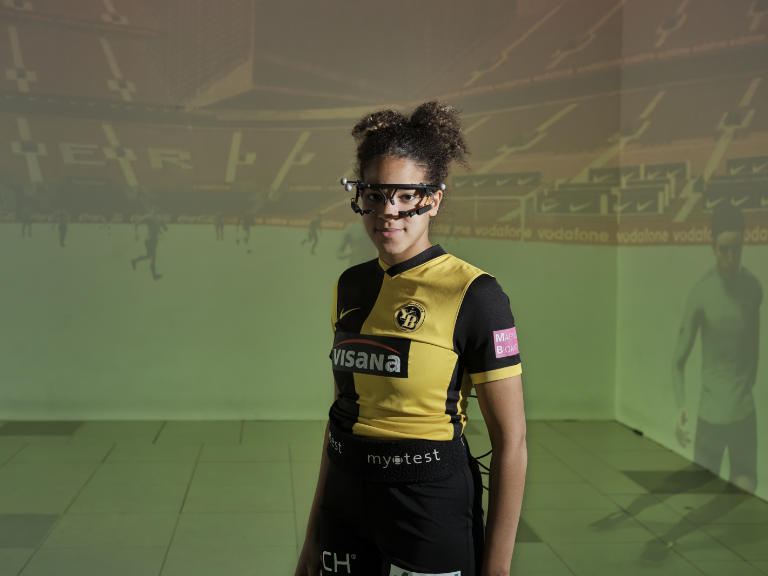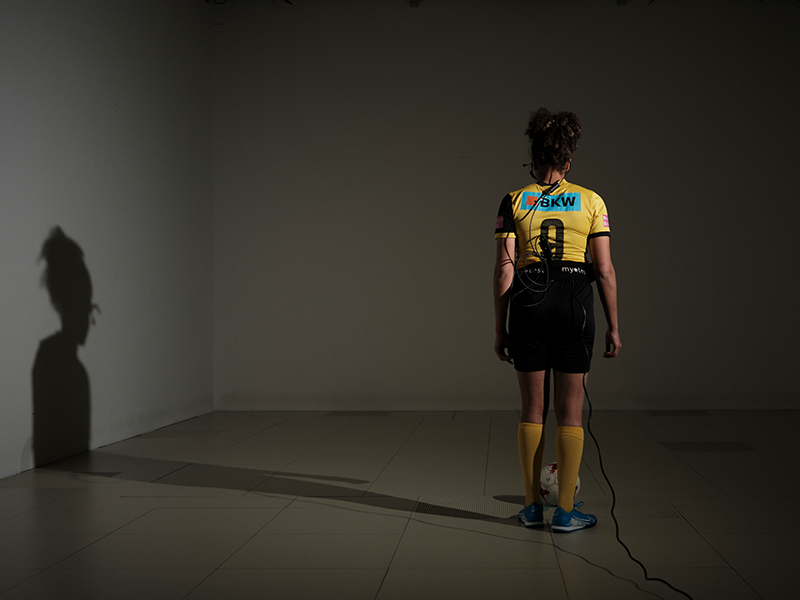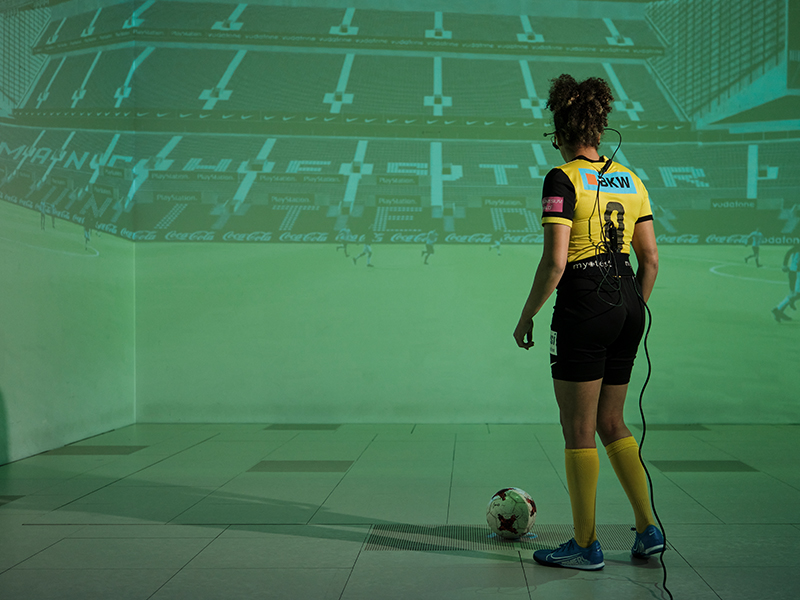Sport Science
In search of the professionals' secret
In the Sensorimotor Lab of the Institute of Sport Science, researchers are investigating the influence of human perception on the actions of athletes in complex situations.

At first glance, the heart of the laboratory section at the Bern Institute of Sport Science (ISPW) does not look much: an empty room measuring 11 x 6 x 4 meters, bare walls, light-colored flooring. It is only when you look at the ceiling that you discover the true treasures of the Sensorimotor Lab. There are 12 projectors, 24 cameras, 12 workstations and 1 sound system. For example, sport scientists use this CAVE environment – CAVE stands for Cave Automatic Virtual Environment – to recreate realistic game situations – both visually and audibly. In doing so, they address questions such as the following: What information do athletes take in during the game? What influences their decisions? And what does a professional athlete do differently from an amateur?
3D glasses with eye tracker
To demonstrate how the Sensorimotor Lab works, Ralf Kredel, head of the lab and a lecturer in Movement and Exercise Science, invited Joni Bandi along. The U19 striker from BSC Young Boys still looks a little lost in the middle of the empty room: She’s in the lab for the first time. She is wearing 3D glasses with an integrated eye tracker, which makes the virtual soccer stadium, which is now projected all around on the walls and floor, as real as possible for her. The glasses are fitted with two tiny infrared cameras that track her eye movements. While Bandi finds her way around the room, takes on a (virtual) ball and passes on the (real) ball, other infrared cameras record her movements in real time and with millimeter accuracy using reflective markers. At the same time, plates in the floor measure the forces occurring. Software developed at the ISPW and the Faculty of Human Sciences coordinates all these data streams and makes it possible, for example, for the virtual environment to adapt to her viewing behavior.
Whether soccer, tennis or beach volleyball: Any sport can be simulated in Bern’s Sensorimotor Lab. Today’s demonstration is about playing creativity; soccer is predestined for this because the sport requires players to make quick decisions in changing situations. A research team from Movement and Exercise Science led by postdoctoral researcher Stephan Zahno discovered in a study that hands-on technique training promotes creatively evaluated game actions far more than the cognitive practice of multiple decision-making options. In practice, these findings mean that trainers should rely more on good technicians than on creative minds when looking for new talent. However, Kredel emphasizes: “The Sensorimotor Lab is not primarily intended for practical training, but for research and diagnostics. We use the expertise of professional athletes to uncover fundamental perception and action mechanisms and to understand how people manage to cope with complex situations – in sport, but also in everyday life.”
“We use the expertise of professional athletes to understand how people manage to cope with complex situations – in sport, but also in everyday life.”
Joni Bandi
Laboratory makes situations comparable
Of course, you also measure the behavior of soccer players during a real game. The experiments in the laboratory are used for comparability. This is important when it comes to conducting experiments on complex human perception, movement and decision-making behavior. “Here, we can confront several athletes with exactly the same situation and measure how they behave. That’s not possible on the pitch,” says Kredel. Researchers can also change the game situation in a targeted manner: For example, how does U19 soccer player Bandi react when her opponent is one meter further to the left or the ball rolls in her direction at a slightly different angle?


Unique in Switzerland
The Sensorimotor Lab has been in operation since 2016 and represents a milestone in sport science research. “In the past, studies were conducted with athletes on computer screens,” says Kredel. However, this has hardly anything to do with a real game situation, and the results of this earlier research are therefore of little use. The high-tech laboratory, on the other hand, can reproduce all the relevant details of a situation in a realistic manner and make it tangible. The Sensorimotor Lab is not the only one, but by far the largest lab at the ISPW. With its dimensions and technical possibilities, it is unique in Switzerland. The fact that the University of Bern has such a CAVE environment has a lot to do with Ralf Kredel: He worked to integrate the laboratory into the institute’s building on Bremgartenstrasse, which opened in 2015. As a sport scientist and electrical engineer, he is not only interested in the content, but also has the technical know-how to help develop, install and carry out maintenance himself – an aspect that has contributed greatly to the success of the project.
“My expectations were exceeded.”
Joni Bandi
Bandi has now changed her yellow-black soccer dress back to normal casual wear. She liked the first virtual training session: “My expectations were exceeded,” she says. What she did miss was the interaction with fellow players. “But the game situation felt very real.”
Virtual realities at the University of Bern
Versatile use
Virtual realities (VR), as used in the Sensorimotor Lab, are deployed in a wide range of projects at the University of Bern.
For example, VR is used to visualize complex data sets in the geosciences. This makes it possible to understand model data of rock structures or aging and fluid transport processes more intuitively.
VR can also have a supportive effect in clinical settings. This helps to reduce stress and pain by moving patients from the stressful operating theater to a more relaxed environment. They are also used in virtual training courses in emergency medicine. This allows even rare situations to be practiced realistically and safely at the same time. This is one of the reasons why VR is also used in teaching.
All in all, almost all faculties are involved in the use of virtual realities. The wide range of expertise in the development and application of VR makes it clear how much synergy potential lies in the networking of stakeholders. For this reason, the focus group “Extended Reality” was founded as part of the University of Bern’s digitalization strategy. It is open to all subject-related members of the University. Interested parties can contact the spokesperson of the focus group, Ralf Kredel.
About the person
Ralf Kredel
Contakt:
Dr. Ralf Kredel
ralf.kredel@unibe.ch